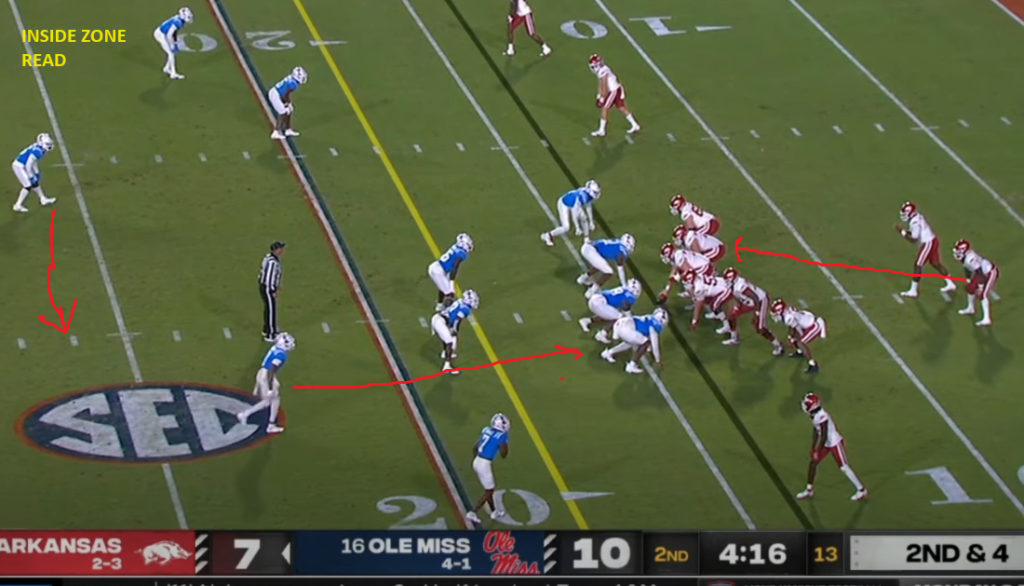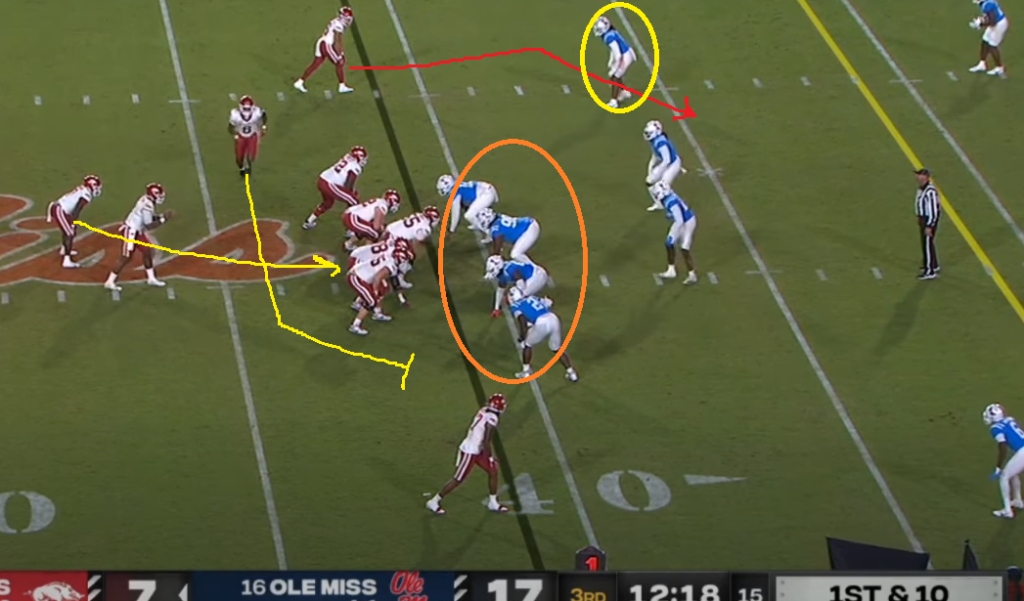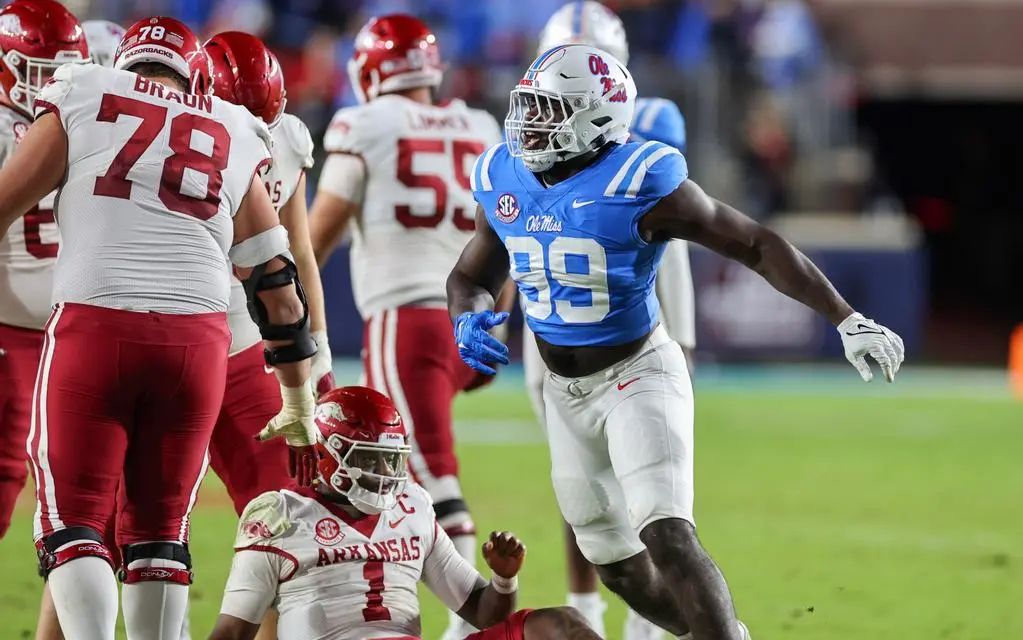This Arkansas football season has been such a disappointment that even the usually-fun Ole Miss rivalry game was boring. After years of fun and high-scoring matchups, these two teams combined for 635 yards of total offense and 47 points in a 27-20 Rebel win. For context, in the 2021 game, Arkansas had 676 yards and 51 points by itself. And in the 2015 game, the Hogs had 605 yards and 53 points alone.
There’s no point in a recap, as you can just look at the recaps of other Hog losses: the Hogs took an early lead, the offense was mostly bad, the defense was mostly good, and the offense ended up giving the other team a short field that provided the decisive score.
Arkansas is the only four-loss team in the country that has led in every game this season. This is the kind of year you’d expect for a first-year coach, not a fourth-year coach. But alas, here we are.
Advanced Stats

Scrimmage offense alone: Arkansas minus-4.2, Ole Miss minus-4.3. Everything else: Arkansas minus-1.5, Ole Miss +4.7. Defense and placekicking were good once again, and everything else was not.

Just like the LSU game, our model thinks that the Hogs were pretty lucky to be in this game, as they were once again behind the chains on offense all day and needed a bomb of a field goal just to still be in at on the final drive. Compared to the projected final of 27-23 Rebels, the Hogs’ offense underperformed by nine points, but the defense overperformed by three. That matches up to the eye test, I’d say.

I’ve made somewhat clear that I was pretty skeptical of the Dan Enos hire because I did not think that was the schematic direction that Arkansas’ offense needed to go, but even I am surprised that Arkansas’ negative play rate has not improved, but has in fact gotten worse. Arkansas has allowed 46 havoc plays in SEC play: that’s more than 15 per game and means that about 24% of all plays in conference play have been stuffed runs, sacks, or turnovers. Arkansas now ranks 120th out of 133 FBS teams in havoc rate allowed.
My theory was that Kendal Briles’ RPO-heavy offense allowed more negative plays because in trying to make the defense guess wrong, sometimes you guess wrong yourself, like when the offense runs a read right into a blitz. I figured that came with the territory. Enos’s first offense (2015-2017) had very few negative plays. Of course, the difference is that since that time, Enos has embraced a more modern scheme similar to Briles. During his first stint, most runs were not reads, but called handoffs. Now Enos uses some RPOs, and almost every called run is a read, so there’s always an unblocked defender and the quarterback must decide whether to hand off and either run it himself (read) or throw (RPO).
The high negative play rate may have more to do with vision than scheme. Let’s look at a critical play in the game: 2nd-and-4 deep in their own territory, late in the first half, Arkansas dials up a simple inside zone read with Rocket Sanders in the game:

The Rebs are blitzing a safety and dropping into Cover 1, giving them seven defenders against six blockers in the box. Normally, you could “read” off an unblocked defender, but Ole Miss does not have a backside edge defender to read (look at how inside the right defensive end is). So Arkansas runs this play as a six-on-seven inside zone and it doesn’t go well:

This is not the offensive line’s fault. Every lineman found his man and blocked, and Brady Latham (who played right tackle in the first half) even deals properly with the little twist the Rebels try on the right side. Right guard Josh Braun actually blocks three people: he helps the center Patrick Kutas on the nose, then peels off and gets pieces of two unblocked linebackers. Ty Washington recognizes the rushing safety and pushes him aside at the last moment.
The problem with this play is that Sanders ran right into where all three of Ole Miss’s linebackers were waiting, completely missing an enormous hole:

I’ve circled Ole Miss’s edge defenders, because they have both completely lost contain due to good blocks. On the backside of the play, left tackle Andrew Chamblee and left guard Beaux Limmer doubled the end, then Chamblee got to the second level to seal off the linebacker. The Ole Miss defensive back at the bottom corner (#7) and the deep safety are the only two guys between Sanders and a touchdown if he cuts that back.
A very similar play happened in the third quarter. Now, the Hogs have an RPO where an inside zone is paired with a backside slant:

The “read” defender is circled in yellow. He stays put against the slant, so this has to be a handoff. Washington is coming on motion to block the backside edge, but as you can see, Ole Miss has once again shifted its line against the back (orange), leaving a potential cutback lane.

So this one is on the line. It looks like this was yet another twist: the nose looped around the end, who slanted inside and knocked Braun out of the way. It looks to me like that’s how it was drawn up. I don’t know enough about how this play is supposed to be executed to know if that’s the fault of Kutas (who stayed with the end who was obviously running himself out of the play), of Braun (who could have done something different, maybe?), or of Limmer, who handed the nose off to Braun pretty quickly (and then whiffed on his attempted second-level block).
Note that neither of these are actually negative plays: both gained one yard. So there 15 worse offensive plays than these. But this gives you an idea of the problem. Arkansas’ offense just doesn’t work. Jefferson often struggles to read coverage and recognize pressure, he’s only somewhat accurate on midrange throws, the backs don’t have very good vision, and the line struggles in pass protection and when dealing with stunts and twists. Arkansas does not do anything particularly well on offense.

As against LSU, the Hogs stayed alive by converting several passing situations, but that’s about all they did well. Once again, they struggled with explosive plays and on early downs, the two stats you have to win if you want to succeed with less talent. The Hogs got lots of stops on Ole Miss’s passing situations, contributing to a very pedestrian night for a very good Rebel offense.

We just looked at a couple run plays, and there’s no hope here. I don’t see any way Arkansas figures out how to run the ball this season. There are too many different things that are not working.

I thought the Hogs did some nice stuff involving Ty Washington, who they often set as a slot receiver and then motioned him inside when they wanted an H-back. I thought he blocked well and did a great job getting open and making catches in the passing game.

Great game for Washington: 7 catches, 90 yards, 100% success, +51% win probability, +15 EPA. But your eyes are not deceiving you: that’s a 0% rushing success rate for Sanders. As in, zero of his eight carries had positive EPA. Arkansas’ backs had 12 carries, and just one was successful.
With the run game dead and buried, Arkansas is going to have to throw it 40-45 times a game from here on in. Called runs should basically go away completely (except for the sneak play!), and instead the Hogs should run more RPOs, so Jefferson can hand off when the look is right. Is that going to work well? Almost certainly not. Jefferson isn’t a pure pro-style passer and will struggle to make many of the throws required to be that pass-heavy, but this is where Arkansas is right now.
Up Next
Arkansas is now staring at a 2-5 start as they head to Tuscaloosa to take on the Tide, who are coming off a big road win over Texas A&M. I would like to see the Hogs compete defensively against Jalen Milroe, but Arkansas is facing a legitimate danger of a shutout on the other side. Alabama throttled Texas A&M’s offensive line and is the most complete defense the Hogs will face all year.
Thanks for reading! Be sure to follow us on Twitter and on Facebook.
The latest from Fayette Villains, straight to your inbox
Enter your email to subscribe and receive new post alerts and other updates. You can unsubscribe at any time.
